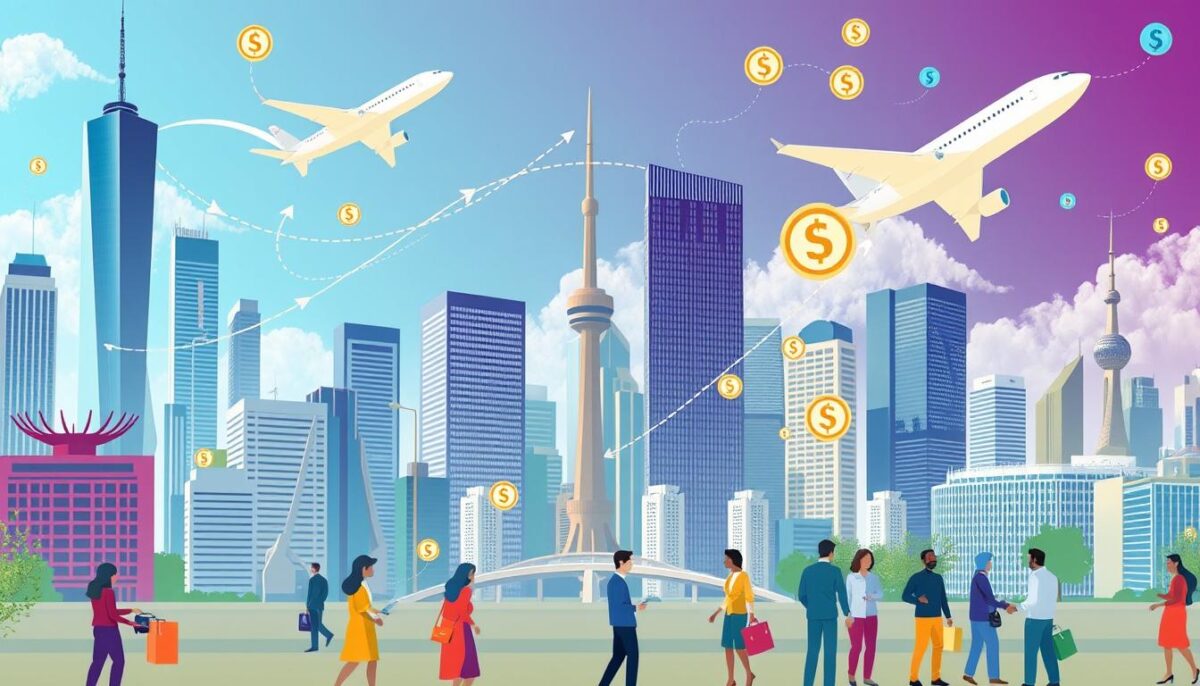In today’s fast world, money troubles can pop up anytime. Luckily, clearance finance is here to help with quick cash. It offers fast approval and good rates, making it a great way to get financial freedom.
So, what is clearance finance and how can it help you? This guide will cover everything you need to know. We’ll walk you through how to apply, who can get it, and what options you have. And most importantly, we’ll ask: Is clearance finance right for you?
Key Takeaways
- Clearance finance offers fast, same-day approval for urgent financial needs
- It provides a flexible and accessible solution for those seeking quick cash
- The application process is streamlined, requiring minimal documentation
- Eligibility criteria focus on income, credit score, and other key factors
- Clearance finance can be used for a variety of personal and financial purposes
Understanding Clearance Finance and Its Benefits
International trade can be tough to handle. But, makes it easier. It helps goods move smoothly across borders. It also makes sure businesses follow trade compliance, export controls, and import regulations.
What is Clearance Finance?
Finance is a special loan for trade. It helps with the costs of moving goods through customs. This way, businesses can keep running smoothly without money problems.
Advantages of Clearance Finance
- It helps manage cash flow better. This means businesses can pay for customs without delays.
- It reduces risks. By taking care of trade rules, it avoids big fines or legal trouble.
- It makes global trade easier. Businesses can focus on what they do best, thanks to experts handling trade details.
Common Uses for Clearance Finance
Clearance finance is great for companies that trade globally. It helps with many costs, like:
- Import duties and taxes
- Export compliance fees
- Customs brokerage and clearance costs
- Storage and handling fees for goods in transit
With finance, businesses can trade internationally smoothly. This opens up new chances for growth worldwide.
“Clearance finance has been a game-changer for our company, allowing us to navigate the complexities of global trade with confidence and efficiency.”
– [CEO Name], [Company Name]
The Application Process for Clearance Finance
Getting customs clearance for international shipments can be tricky. But, with the right financing, it’s easier. Finance helps pay for customs duties and fees, making the process smoother. Let’s look at how to apply for this helpful financial tool.
Steps to Apply
- Gather the necessary documents, like invoices and shipping manifests.
- Figure out how much you’ll need for customs clearance costs.
- Look for different finance providers to find the best one for you.
- Fill out the application, which might ask for financial info and credit checks.
- Wait for approval and get the funds to cover your customs clearance costs.
Documentation Required
For a clearance finance application, you’ll need:
- Invoices or commercial documents for the goods
- Shipping manifests or bills of lading
- Proof of identity, like a driver’s license or passport
- Financial statements or tax returns
- Any extra info the provider might ask for
Approval Timeline
The time it takes to get approval for clearance finance varies. It can be a few days to a few weeks. It’s smart to apply early to avoid delays in customs clearance. Using finance can make your international shipping smoother, saving you time and money.
ce Finance Inc.3-5 business days8.5% – 18%$5,000
| Lender | Approval Timeline | Interest Rates | Minimum Loan Amount |
|---|---|---|---|
| Clearan | |||
| Global Customs Financing | 1-2 weeks | 6% – 15% | $10,000 |
| Shipping Advance Solutions | 5-7 business days | 9% – 20% | $2,500 |
Eligibility Criteria for Clearance Finance
To get clearance finance, you must meet certain requirements set by lenders. These requirements focus on your financial stability and creditworthiness. This ensures you can repay the loan on time. Let’s explore the key factors that affect your eligibility for finance.
Minimum Income Requirements
Lenders have a minimum income requirement for applicants. This ensures you can afford the loan payments. The income needed varies based on your job, stability, and financial situation.
Credit Score Expectations
Your credit score is very important for getting. Lenders check your credit history to see if you’re a good risk. A higher credit score means you’re more likely to get approved, showing you handle money well.
Other Factors Influencing Eligibility
Other things also matter for clearance finance eligibility. These include your trade history, supply chain performance, and financial stability. Lenders also look at the loan’s purpose and the risk involved.
| Eligibility Factor | Typical Requirement |
|---|---|
| Minimum Income | $50,000 or higher |
| Credit Score | 700 or higher (on a scale of 300-850) |
| Trade History | Minimum 2 years of established global trade facilitation experience |
| Supply Chain Logistics | Demonstrable efficiency and reliability in supply chain operations |
Remember, different lenders have different criteria for clearance finance. It’s smart to research and compare to find the best option for you.
Types of Clearance Financing Options
Businesses and individuals have many financing options for cross-border transactions and trade finance. These include personal loans, lines of credit, and payday loans. Each has its own benefits and drawbacks. Let’s explore these options further.
Personal Loans
Personal loans are a common choice for funding cross-border deals. They offer a fixed amount of money with competitive interest rates and flexible repayment plans. This makes them suitable for both businesses and individuals with good credit. Personal loans can cover various expenses, like inventory or transportation costs.
Lines of Credit
A line of credit gives access to funds as needed. It’s great for those with changing cash flow or ongoing trade finance needs. This option allows for borrowing, repaying, and borrowing again as needed. Lines of credit often have lower interest rates than payday loans, making them more cost-effective for long-term needs.
Payday Loans
Payday loans are for immediate cash needs. They offer quick access to funds, usually between $100 and $1,000. While they can be helpful, it’s crucial to understand the fees and repayment terms to ensure they fit your financial situation.
| Financing Option | Typical Loan Amount | Interest Rates | Repayment Terms |
|---|---|---|---|
| Personal Loans | $1,000 – $50,000 | 6% – 36% | 1 – 5 years |
| Lines of Credit | $5,000 – $100,000 | 5% – 25% | Revolving |
| Payday Loans | $100 – $1,000 | 100% – 400% | 2 – 4 weeks |
Choosing the right financing option for cross-border transactions or trade finance is key. It’s important to look at the terms, fees, and repayment schedules. This ensures the option fits your financial goals and capabilities. By understanding each option’s pros and cons, you can make a choice that supports your business or personal goals.
 height=”686″ />
height=”686″ />
How to Use Clearance Finance Responsibly
Using clearance finance wisely is key to a healthy financial life. We’ll look at important steps to make the most of clearance finance. These steps will help you on your financial journey.
Setting a Budget
First, you need a budget that shows your financial goals and what you owe. Look at your income, expenses, and debt to decide how much to spend on clearance finance. This way, you won’t overspend and can keep your finances in check.</p>
Understand
ing Fees and Interest Rates
Clearance finance deals come with fees and interest rates that affect the total cost. It’s important to know these details and compare offers. Look at the annual percentage rate (APR), origination fees, and other charges to make smart choices and avoid surprises.
Planning for Repayment
Having a solid repayment plan is crucial. Create a timeline for paying back the loan and make sure your monthly payments fit your budget. Paying on time improves your credit score and opens doors for future financial opportunities.
By following these steps, you can use clearance finance wisely and protect your financial health. Making smart choices now will lead to a better financial future.
Where to Find Clearance Finance Providers
Finding the right clearance finance provider is key. It can be tough to choose between online and in-person options. But, by looking at reviews and recommendations, you can find what works best for you.
Online vs. In-Person Lenders
Online lenders make getting finance easy and fast. They have quick apps and fast approvals. But, make sure they follow export controls and import regulations to protect your money.
Local lenders offer a personal touch and can understand your area’s economy better. They can guide you through the finance world.
Recommendations for Trustworthy Lenders
- Look up lenders’ reputations and what customers say online.
- Check if the lender is licensed and follows export controls and import regulations.
- Ask friends, family, or financial advisors for lender recommendations.
Importance of Reading Reviews
Reading reviews is crucial. They show how reliable and helpful a lender is. Look at how they handle questions, apps, and problems. This helps you pick a trustworthy lender for your finance needs.

Comparing Clearance Finance Offers
When looking for financing for customs clearance or international shipping, it’s important to compare offers. This helps you find the best fit for your needs and budget. Let’s look at what to consider when comparing these options.
Key Features to Look For
When checking out different finance offers, focus on these key features:
- Loan amount and limits
- Repayment terms and flexibility
- Interest rates and associated fees
- Application requirements and processing time
- Any special features or services related to customs clearance or international shipping
How to Assess Interest Rates
Interest rates greatly affect the cost of your finance solution. When comparing, look beyond the APR. Consider these factors:
- Understand the difference between fixed and variable interest rates, and how they may affect your long-term costs.
- Compare the annual percentage rates (APRs) across multiple lenders to find the most competitive option.
- Inquire about any additional fees or charges that may be associated with the interest rates, such as origination fees or prepayment penalties.
Understanding Terms and Conditions
It’s vital to review the terms and conditions of each offer. Pay attention to these details:
- Repayment schedules and due dates
- Any penalties or fees for late or missed payments
- Restrictions or limitations on how the funds can be used, especially concerning customs clearance or international shipping
- Provisions for early repayment or refinancing
By comparing finance offers carefully, you can make a smart choice. This choice will support your customs clearance and international shipping needs.</p>
Common Misconceptions About Clearance Finance
There are many myths about clearance finance that need to be cleared up. Knowing the truth about this financial tool helps us decide when it’s right and when it’s not. This is especially true when thinking about global trade and supply chain logistics.
Debunking Myths
One big myth is that only people with bad credit can get clearance finance. But, many lenders offer it to those with good credit too. Another myth is that clearance finance is always too expensive and unfair. While some fees can be high, there are also affordable options out there.</p>
Realities
of Clearance Finance
- Clearance finance gives quick access to cash for many needs, like unexpected bills or business growth.
- Good lenders offer clearance finance with fair rates and flexible payback plans. This makes it a solid choice for many.
- It can help with global trade and make supply chains smoother by providing the cash needed to move goods and services.</li>
When it Might Not Be Suitable
Clearance finance is useful but not always the best choice. For long-term money problems or big purchases, other loans might be better. Always think about your financial situation and all your options before deciding.
<table><th>MythRealityClearance finance is only for people with poor creditMany lenders offer clearance financing to borrowers with a range of credit profilesClearance finance is always expensive and exploitative</td>There are affordable and transparent clearance finance options availableClearance finance has no role in global trade facilitation</b> or supply chain logisticsClearance finance can provide the necessary liquidity to support international trade and streamline logistics</tbody>
By understanding these myths and the real deal about clearance finance, we can make better choices. This helps us achieve our goals while considering its effects on global trade and supply chains.
 width=”1200″ height=”686″ />
width=”1200″ height=”686″ />
Frequently Asked Questions About Clearance Finance
Exploring cross-border transactions and trade finance solutions can raise many questions. Let’s tackle some common ones to help you understand clearance finance better.
<h3>What Happens If I Default?
Defaulting on a clearance finance deal can lead to big problems. You might face late fees, hurt your credit score, and even legal trouble. Always check the agreement’s terms and make sure you can pay on time. If you’re worried, talk to your lender about possible solutions.
Can I Reapply for Clearance Finance?
Yes, you can apply again if your first attempt was turned down. But, you need to fix any issues that caused the denial, like bad credit or low income. Improve your finances, gather more documents, and meet the lender’s criteria before applying again. A denial doesn’t mean you can’t get clearance finance later.
What Should I Do If My Application is Denied?
If your application is denied, don’t give up. Find out why it was denied and work on those areas. Get your credit report, fix any problems, and consider financial advice. You might also look into other trade finance options, like factoring or asset-based lending, for your needs.
FAQ
<div>
What is Clearance Finance?
Clearance finance helps businesses and individuals with international trade. It makes sure goods clear customs smoothly. This ensures efficient transactions across borders.</p>
</div>
What are the key advantages of using Clearance Finance?
Using Clearance Finance improves cash flow and reduces risks. It also helps with trade compliance. This way, businesses can manage their capital and follow export and import rules.
What are the common uses for Clearance Finance?
It’s used for buying inventory, covering customs duties, and shipping logistics. It also funds global supply chain growth and cross-border deals.
</div>
What are the steps to apply for Clearance Finance?
First, share your business info and submit needed documents. Then, we review your credit. Our team will help you through the customs clearance process.
</div>
What are the eligibility criteria for Clearance Finance?
Eligibility depends on income, credit score, and trade history. We look at your financial profile and supply chain performance to decide.
What types of Clearance Financing options are available?
We offer personal loans, lines of credit, and payday loans. Each is customized for clients in global trade and cross-border transactions.
How can I use Clearance Finance responsibly?
Set a budget, know fees and interest, and plan to repay on time. Also, follow trade rules and be transparent.
</div>
Where can I find reputable Clearance Finance providers?
Look online and traditional lenders. Check their reputation, trade compliance, and client reviews for a trustworthy partner.</p>
How can I compare Clearance Finance offers?
Focus on interest rates, terms, and fees. Understand the details to choose the best for your needs.
</div>
What are some common misconceptions about Clearance Finance?
Some think it’s only for big companies, too expensive, or for specific trades. We clear these myths, showing its benefits for all businesses in global trade.







